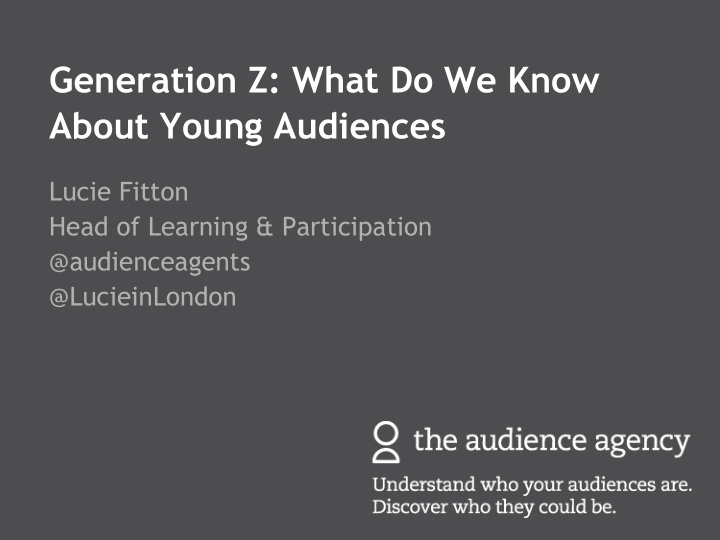



Generation Z: What Do We Know About Young Audiences Lucie Fitton Head of Learning & Participation @audienceagents @LucieinLondon
Introduction • Who we are? • What I am here to share? • Why do we know this? • Insight events • Audience Finder • Audience Spectrum (data sources) • In-depth research
A quick word about the lingo
Who are Gen Z?
Who are Generation Z? • Up to 19/20 years old Inspired by a small number of the generation before - • Super-visual self-made makers, creators and entrepreneurs • ‘Tech innate’ • Need a cause • Hard-working realists • Makers not consumers • Born collaborators and problem solvers
• Not motivated by relaxation • Major reason for non- attendance is lack of time and lack of interest • Life impacted on and influenced by more people • As a result of being more active, likely to be more activities they’re engaging with regularly too
How to engage Gen Z?
Outside the comfort zone • World shaping highly personalised news feeds = magnification of echo chamber • Lack of variety, surprise, new views • Arts organisations = breaking out of the loop • Livity – Off Road project
Beyond participating & making to curating experiences • Opportunities for creating and attending expertly curated offers • Opportunities for building socially minded entrepreneurial skillset? – e.g. Beatfreaks ‘ Artivism ’
Be more comfortable with ‘raw’ • Be less attached to a shiny glossy product • Offer the raw and imperfect • Allow opportunities for young people to feed in and develop – own and share
Supporting long term access • Why pay or download when they are used to streaming or having memberships with long term access? • How to be more creative and sophisticated about membership and loyalty for young people – Barbican research – socialising the experience, exclusive access, VIP
Social – bonding not bridging • More so than older adults; Used to spending time in larger groups at school, college • Motivations for engaging often driven by friendship • Bonding rather than bridging: (Initially)require activities that can provide them with place to spend time with peers How can every interaction with you become a sociable • Space-led activities rather than one? Even the booking activity led experience • Cross artform, taster based activities
Communications – confidence and co-creation • Upwards and outwards • Reflecting on our Insight event speakers - slick • Content already strong – but how to communicate this? Need for visual communications • Learn from other sectors esp. financially driven • Invite young people to shape it – marketing & communications is part of engagement and learning
Beyond Gen Z – younger people more broadly and the bigger picture
The bigger picture • The potential of big data sets • Audience Finder • Age limitations – but useful for 16+ • Using patterns of current arts engagement to help predict what audiences we could be reaching in ten or twenty years
Number of performances 1,070,644 Number of bookers 16,675,313 Number of transactions 59,983,816 Tickets issued 174,753,544 Income £3,451,661,373.09 Total surveys collected Approx. 280,000 Survey dashboards 325 active surveys / 698 total orgs surveyed in AF Contributing organisations 538 current / 818 total Registered users 6,846
Myth = An ageing population is a market opportunity for arts and culture
Quick headlines from Audience Finder analysis • Average age of audiences for publically supported arts and culture is rising • Especially for classical music, opera and mainstream theatre • The average age of museum attenders is lower but still rising (though more slowly) • Only audiences for contemporary art, independent film, outdoor arts and sub- genres, like site-specific and physical theatre, consistently show a higher proportion of younger audiences
Young people are not becoming their parents • If profiles stay the same, average age of audiences for “classic work” will increase considerably • Three top arts-attending groups set to age more than the population • Younger “Experience seekers” prefer other art forms/ Is there a potential experiences – don’t follow their future crisis? parents’ habits • The gap between the habits of older and younger audiences gets wider
Predicting the future? • Audiences continue to grow: to spend more, do more, donate more • Audiences overall are older and less interested in new forms and practice • Younger audiences are increasingly restricted to contemporary artforms • Younger audiences are more diverse
Predicting the future? • Audiences plateau, start to decline • Baby Boomers face more barriers, frequency declines In 15 years • Younger audiences do not migrate to classic artforms • Majority seek a different kind of cultural offer BUT on a positive note • More adults than ever before have tertiary education – highest predictor of arts engagement • Social/ethnic diversity increases in society, and in our audiences
Responding… • More flexible, relaxed visitor experiences – eg flexible booking, refunds, try-before-you- buy, social space, personal devices • Changes in price-sensitivity - freemium content • Increased interest in curated experiences (festivals) • Shelf-life of product-content - respond agile way to demand
Responding…. • Radical changes to loyalty development – direct marketing to membership • Service/ programme design through dialogue and interactivity • Accommodating audiences with strongly divergent preferences
Responding…. • Start relationships earlier • Create new experiences which encourage life- long engagement • Participation and family attendance vital • Immersive young people’s programmes • Better understanding of young people – not an homogenous group
Cultural segmentation young people?
Finding out more http://www.artsprofessional.co.uk/ magazine/article/reaching-out- young-people http://www.artsprofessional.co.uk/ magazine/article/bridging- generation-gap
Audience Spectrum
Free mapping tools in Audience Finder
Stay in touch lucie.fitton@theaudienceagency.org @LucieinLondon @audienceagents theaudienceagency.org
Questions
Good practice, good ideas Three questions
1. Opportunities? What do you see as the biggest opportunities and challenges in navigating the age-gap? 2. Anticipating need? What is your organisation is doing to anticipate the changing needs of post Baby-boomer generations? 3. Support? What resources or support do we need to respond?
Recommend
More recommend